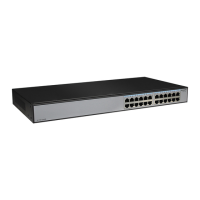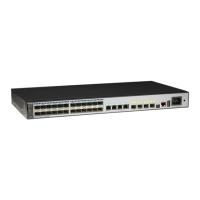The switchs of this type can belong to more than two areas, but one of the areas must be a
backbone area. An ABR is used to connect the backbone area to the non-backbone areas.
An ABR can be physically or logically connected to the backbone area.
l Backbone routers
A minimum of one interface on the switch of this type belongs to the backbone area.
Therefore, all ABRs and the internal nodes in Area 0 are backbone routers.
l AS boundary routers (ASBRs)
The switch that exchanges routing information with other ASs is called an ASBR. The
ASBR may not be located on the boundary of an AS. It can be an internal router or an ABR.
When an OSPF device imports the external routing information, the device becomes an
ASBR.
Figure 4-2 Types of OSPF routers
Area3
Area0
Area1
Area2
Area4
Internal
Router
ABR
Backbone
Router
ASBRIS-IS
OSPF Network Types
OSPF classifies networks into four types according to the link layer protocol:
l Broadcast: If the link layer protocol is Ethernet or FDDI, OSPF defaults the network type
to broadcast. In this type of networks, the following situations occur.
– Hello packets and packets from the Designated Router (DR) are sent in multicast mode
(224.0.0.5: indicates the reserved IP multicast addresses for OSPF routers).
– Link State Update (LSU) packets are sent to the DR in multicast mode (224.0.0.6:
indicates the reserved IP multicast address for the OSPF DR), and the DR forwards the
LSU packets to destination 224.0.0.5.
– Database Description (DD) packets, Link State Request (LSR) packets, and all
retransmission packets are sent in unicast mode.
– Link State Acknowledgement (LSAck) packets are usually sent in multicast mode
(224.0.0.5). When a switch receives repeated LSAs, or the LSAs are deleted due to the
timeout of the maximum lifetime, LSAck packets are sent in unicast mode.
l Non-Broadcast Multi-Access (NBMA): If the link layer protocol is Frame Relay, ATM, or
X.25, OSPF defaults the network type to NBMA. In this type of networks, protocol packets,
S6700 Series Ethernet Switches
Configuration Guide - IP Routing 4 OSPF Configuration
Issue 01 (2012-03-15) Huawei Proprietary and Confidential
Copyright © Huawei Technologies Co., Ltd.
86

